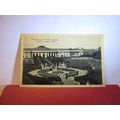Athens, Greece - Kapvalides Caryatids - art postcard, nice stamps 1952 pmk
- Condition : Used
- Dispatch : 2 Days
- Brand : None
- ID# : 185833362
- Quantity : 1 item
- Views : 93
- Location : United Kingdom

- Seller : justthebook (+1703)
- Barcode : None
- Start : Sat 05 Oct 2019 07:23:09 (EDT)
- Close : Run Until Sold
- Remain : Run Until Sold
Checks/Cheques
 for 1 item(s) edit
for 1 item(s) edit
Shipping Calculator
More Listings from This Seller view all
Seller's Description
- Postcard
- Picture / Image: Kapvalides Caryatids, Athens - art view of the building
- Publisher: Edition Theo
- Postally used: yes
- Stamp: Athens 200 + 1000 values (see scan)
- Postmark(s): Athens 1952 cds
- Sent to: Miss J Cummings, 7 Lordsbury Fields, Wallington, Surrey, England
- Notes / condition:
Please ask if you need any other information and I will do the best I can to answer.
Image may be low res for illustrative purposes - if you need a higher definition image then please contact me and I may be able to send one. No cards have been trimmed (unless stated).
------------------------------------------------
Postage & Packing:
Postage and packing charge should be showing for your location (contact if not sure).
No additional charges for more than one postcard. You can buy as many postcards from me as you like and you will just pay the fee above once. Please wait for combined invoice. (If buying postcards with other things such as books, please contact or wait for invoice before paying).
Payment Methods:
UK - PayPal, Cheque (from UK bank) or postal order
Outside UK: PayPal ONLY (unless otherwise stated) please. NO non-UK currency checks or money orders (sorry).
NOTE: All postcards are sent in brand new stiffened envelopes which I have bought for the task. These are specially made to protect postcards and you may be able to re-use them. In addition there are other costs to sending so the above charge is not just for the stamp!
I will give a full refund if you are not fully satisfied with the postcard.
----------------------------------------------
Text from the free encyclopedia WIKIPEDIA may appear below to give a little background information (internal links may not work) :
*************
A caryatid (/ˌkæriˈætɪd/ KARR-ee-AT-id; Greek: Καρυάτις, plural: Καρυάτιδες) is a sculpted female figure serving as an architectural support taking the place of a column or a pillar supporting an entablature on her head. The Greek term karyatides literally means "maidens of Karyai", an ancient town of Peloponnese. Karyai had a temple dedicated to the goddess Artemis in her aspect of Artemis Karyatis: "As Karyatis she rejoiced in the dances of the nut-tree village of Karyai, those Karyatides, who in their ecstatic round-dance carried on their heads baskets of live reeds, as if they were dancing plants".[1]
An atlas or telamon is a male version of a caryatid, i.e. a sculpted male statue serving as an architectural support of a column.
Some of the earliest known examples were found in the treasuries of Delphi, dating to about the 6th century BC, but their use as supports in the form of women can be traced back even earlier, to ritual basins, ivory mirror handles from Phoenicia, and draped figures from archaic Greece.
The best-known and most-copied examples are those of the six figures of the Caryatid Porch of the Erechtheion on the Acropolis at Athens. One of those original six figures, removed by Lord Elgin in the early 19th century, is now in the British Museum in London. The Acropolis Museum holds the other five figures, which are replaced onsite by replicas. The five originals that are in Athens are now being exhibited in the new Acropolis Museum, on a special balcony that allows visitors to view them from all sides. The pedestal for the Caryatid removed to London remains empty. From 2011 to 2015, they were cleaned by a specially constructed laser beam, which removed accumulated soot and grime without harming the marble's patina. Each Caryatid was cleaned in place, with a television circuit relaying the spectacle live to museum visitors.[2]
Although of the same height and build, and similarly attired and coiffed, the six Caryatids are not the same: their faces, stance, draping, and hair are carved separately; the three on the left stand on their right foot, while the three on the right stand on their left foot. Their bulky, intricately arranged hairstyles serve the crucial purpose of providing static support to their necks, which would otherwise be the thinnest and structurally weakest part.
The Romans also copied the Erechtheion caryatids, installing copies in the Forum of Augustus and the Pantheon in Rome, and at Hadrian's Villa at Tivoli. Another Roman example, found on the Via Appia, is the Townley Caryatid.[citation nee
In Early Modern times, the practice of integrating caryatids into building facades was revived, and in interiors they began to be employed in fireplaces, which had not been a feature of buildings in Antiquity and offered no precedents. Early interior examples are the figures of Hercules and Iole carved on the jambs of a monumental fireplace in the Sala della Jole of the Doge's Palace, Venice, about 1450.[3] In the following century Jacopo Sansovino, both sculptor and architect, carved a pair of female figures supporting the shelf of a marble chimneypiece at Villa Garzoni, near Padua.[4] No architect mentioned the device until 1615, when Palladio's pupil Vincenzo Scamozzi included a chapter devoted to chimneypieces in his Idea della archittura universale. Those in the apartments of princes and important personages, he considered, might be grand enough for chimneypieces with caryatid supporters, such as one he illustrated and a similar one he installed in the Sala dell'Anticollegio, also in the Doge's Palace.[5]
Listing Information
| Listing Type | Gallery Listing |
| Listing ID# | 185833362 |
| Start Time | Sat 05 Oct 2019 07:23:09 (EDT) |
| Close Time | Run Until Sold |
| Starting Bid | Fixed Price (no bidding) |
| Item Condition | Used |
| Bids | 0 |
| Views | 93 |
| Dispatch Time | 2 Days |
| Quantity | 1 |
| Location | United Kingdom |
| Auto Extend | No |















![SINGAPUR SINGAPORE [1985] MiNr 0471 ( O/used ) ...](https://pic.ebid.net/upload_small/3/6/7/1447777614-30987-1.jpg)





